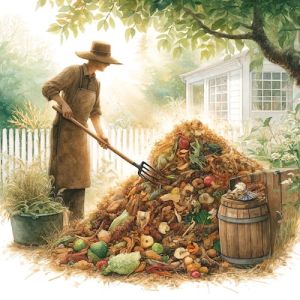Introduction
Are you interested in reducing waste while enriching your garden’s soil? Composting is the answer! Composting is an eco-friendly practice that transforms organic waste into nutrient-rich compost. In this comprehensive guide, I will delve into the science and art of composting, providing you with everything you need to start turning kitchen scraps and garden waste into beneficial soil enhancers. For gardeners, there is nothing more rewarding than the “black gold” that comes out the composting process, that you can immediately apply to your garden for amazing growth and results. Read on for some background info, and basic overview of how to compost.
Why Do We Compost?
Composting is more than just a gardening trend; it’s a movement toward sustainability and mindful living. Everyone can do it, and do their little part in reducing the pressure on landfills, and beautifying their landscape. Here’s why composting is essential:
- Waste Reduction– By composting, you divert organic waste away from landfills, reducing methane emissions, a potent greenhouse gas. This helps fight climate change and promotes environmental health.
- Cost Savings– Composting reduces the need for chemical fertilizers, saving money on garden supplies. It also decreases waste disposal costs, as fewer trips to the landfill are necessary.
- Sustainability– Composting creates a closed-loop system, recycling organic materials into soil enhancers that nourish plants. This sustainable practice reduces reliance on synthetic fertilizers, promoting a healthier ecosystem.
The Science Behind Composting
Composting is a natural process driven by microorganisms like bacteria, fungi, and invertebrates that decompose organic material. This decomposition releases essential nutrients, creating a balanced, dark, and crumbly substance that improves soil structure and fertility.
The process of breakdown can involve two primary types of decomposition:
- Aerobic Decomposition– Microorganisms that require oxygen break down organic material rapidly, generating heat that accelerates the process. Aerobic composting is efficient, producing nutrient-rich compost. What we want in the composting process.
- Anaerobic Decomposition– In the absence of oxygen, anaerobic microorganisms take over, resulting in slower decomposition and unpleasant odors. To prevent this, turn the compost pile regularly to maintain an aerobic environment. What we don’t want.
Greens and Browns
The key to successful composting lies in balancing “greens” and “browns”:
- Greens– Nitrogen-rich materials such as fruit and vegetable scraps, coffee grounds, and grass clippings. These accelerate decomposition by feeding microorganisms.
- Browns– Carbon-rich materials like dry leaves, straw, cardboard, and paper. Browns provide structure to the pile, preventing compaction and allowing air circulation.
It’s All About the Temperature
A good temperature range for a compost pile typically falls between 130°F to 160°F (54°C to 71°C). This temperature range is considered optimal for promoting rapid decomposition by aerobic microorganisms. It also helps to kill weed seeds, pathogens, and other harmful organisms that might be present in the compost pile.
| Temperature Range | Decomposition Stage | Notes |
|---|---|---|
| Below 70°F (21°C) | Dormant | Decomposition slows down significantly, microbial activity is minimal. |
| 70°F – 130°F (21°C – 54°C) | Mesophilic (Moderate Heat) | Moderate microbial activity, gradual decomposition. |
| 130°F – 160°F (54°C – 71°C) | Thermophilic (High Heat) | Optimal range for rapid decomposition, kills weed seeds and pathogens. |
| Above 160°F (71°C) | Overheated | Microbial activity slows down or stops, potential to kill beneficial microbes. |
Temperatures below this range can slow down the decomposition process, while temperatures significantly higher than 160°F (71°C) can kill beneficial microorganisms, leading to a stalled compost pile. Therefore, maintaining the temperature within this range is crucial for an efficient and healthy composting process.
The Art of the Compost Pile
Master Gardner Tip: Size matters in composting – Chop or shred larger materials like branches, cardboard, and vegetable scraps before adding them to the pile. Smaller particles decompose more quickly, resulting in faster composting and a more uniform finished product.
Building a successful compost pile is both a science and an art. Here’s how to master the process-
- Location– Choose a spot with good drainage and partial sunlight.
- Layering– Alternate layers of greens and browns, starting with a base layer of browns to promote aeration.
- Size– Aim for a minimum of 3 feet in width, length, and height to ensure sufficient heat for decomposition.
Starting the Pile
To kickstart the decomposition process, follow these steps:
- Mixing– Blend greens and browns to provide a balanced diet for microbes.
- Moisture– Keep the pile as moist as a wrung-out sponge by adding water if needed.
- Aeration– Turn the pile regularly to introduce oxygen, which promotes microbial activity and prevents foul odors.
Maintenance to Make It Work
Once established, maintain your compost pile with these tips:
- Turning– Turn the pile every 1-2 weeks to mix and aerate.
- Monitoring– Check the pile’s temperature and moisture regularly. Hot piles indicate active decomposition, while dry or soggy piles may need adjustment.
- Feeding– Continuously add organic material, ensuring a balance of greens and browns.
Typical Mistakes
Avoid these common composting pitfalls-
- Imbalance– Too many greens can lead to a smelly pile, while too many browns slow decomposition.
- Neglect– Failing to turn or water the pile can result in anaerobic conditions and bad odors.
- Piling Up Non-compostables– Avoid adding materials like meat, dairy, or treated wood, as these can attract pests and disrupt decomposition.
The Results
Composting is a rewarding practice that reduces waste, enriches your garden, and benefits the environment. By balancing greens and browns, building and maintaining a compost pile, and avoiding common mistakes, you can create valuable compost to nourish your plants. Start composting today and watch your garden flourish!
Want to read more? See our Composting FAQ
Recent Posts

The Power of Mounding: An Essential Gardening Technique for Healthy Plants

The Ultimate Guide to Philodendron Birkin – Care, Tips, and Benefits

Watering Plants – Indoor Edition

The Advantages of Built-Up Garden Beds: A Gardener’s Best Friend

The Secret Weapon for Lush Blooms: How to Create the Perfect Fertilizer Schedule










